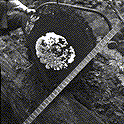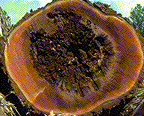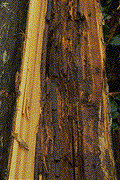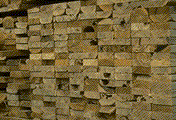Archived Content
Information identified as archived on the Web is for reference, research or recordkeeping purposes. It has not been altered or updated after the date of archiving. Web pages that are archived on the Web are not subject to the Government of Canada Web Standards. As per the Communications Policy of the Government of Canada, you can request alternate formats on the Contact Us page.
Brown Cubical Butt and Pocket Rot of Cedar
Postia sericeomollis (Romell) Jülich
(= Oligoporus sericeomollis (Romell) Pouz.)
(= Polyporus sericeomollis Romell)
(=Poria sericeomollis (Romell) Egeland)
(=Poria asiatica (Pilát) Overholt)
Basidiomycotina, Aphyllophorales, Polyporaceae
Hosts: In B.C., Postia sericeomollis has been reported on most conifers including western redcedar, subalpine fir, western larch, Engelmann, white, and Sitka spruce, lodgepole and ponderosa pine, Douglas-fir, yellow cedar, and western hemlock. Elsewhere in North America it has also been found on grand fir, western white pine, juniper, and cherry.
Distribution: This fungus is widely distributed throughout the range of its hosts in B.C.
Identification: The fruiting bodies are annual, resupinate, thin, up to 15 cm wide, and white. They rarely, if ever, appear on living trees but form on the ends of logs or on slash (Fig. 24a).
The incipient decay is straw-coloured to pale yellow-brown. Later the wood turns light brown, becomes brittle, and breaks down into cubes to form a cylinder of rot (usual when in the butt) or a series of isolated pockets that may run together to form arcs or concentric rings of decayed wood (Figs. 24b, 24c, 24d, 24e). A thin, white weft of mycelium may sometimes form between the cubes.
Microscopic Characteristics:Hyphae in the fruiting body hyaline, thin or thick-walled, with abundant clamp connections. Basidiospores oblong to cylindric-ellipsoid, hyaline, smooth, IKI-, 4-5 x 2-2.5 µm. Growth in culture very slow, mat white, chlamydospores with thick rough walls, laccase negative. Stalpers: (8) (9) (10) 11 (12) (13) 14 17 (19) 21 22 (23) (25) 30 (31) 36 39 42 44 45 (48) 52 53 54 83 85 90.
Damage: This decay is very common in the butt logs of western redcedar, resulting in significant volume losses in both interior and coastal trees. Brown cubical rot symptoms are commonly found in cedar lumber (Fig. 24e) but the decay is not known to develop further in wood in service.
Remarks: Cedar pocket rot is an important butt and trunk decay of western redcedar, ranking second to Phellinus pini as the most common decay in that species. Postia sericeomollis could be confused with Phaeolus schweinitzii. Decay in the former, however, usually forms in pockets or rings of decay, whereas P. schweinitzii usually forms a single column of decay in the centre of the stem. This distinction may be less clear in the stump than higher in the stem. In addition, P. schweinitzii is rarely found in western redcedar.
References:
Buckland, D. C. 1946. Investigations of decay in western redcedar in British Columbia. Can. J. Bot. 24:158-181.
Figures
Click on any image to see the full size version.
Press "Back" on your browser to return to this screen.

Figure 24a: Resupinate sporophore of Postia sericeomollis on western redcedar.
 Figure 24b: Brown cubical rot in western redcedar.
Figure 24b: Brown cubical rot in western redcedar.
 Figure 24c: Brown cubical rot in western redcedar.
Figure 24c: Brown cubical rot in western redcedar.
Figure 24d: Brown cubical rot in western redcedar.
 Figure 24e: Brown cubical rot in cedar lumber.
Figure 24e: Brown cubical rot in cedar lumber.
 This Web page has been archived on the Web.
This Web page has been archived on the Web.